Failed flight "Vulture"
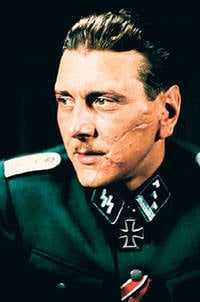 On the early morning of December 18, 1944, in front of the bridge over the Meuse River in the Belgian city of Dinan, 90 kilometers from the front line, a U.S. Army patrol stopped a jeep with four American soldiers. They did not know the password, but confidently answered all the questions. Documents 5th tank the divisions were also in perfect order. They already wanted to let go when Captain Wainwright from CCA (CIC, US Army counterintelligence in World War II), having seen narrow slots on the headlights of a jeep, sent a machine gun to the "tankers": "Are you Germans?" ("Are you Germans?"). Those reluctantly raised their hands. These were saboteurs of Obersturmbannführer Skorzeny.
On the early morning of December 18, 1944, in front of the bridge over the Meuse River in the Belgian city of Dinan, 90 kilometers from the front line, a U.S. Army patrol stopped a jeep with four American soldiers. They did not know the password, but confidently answered all the questions. Documents 5th tank the divisions were also in perfect order. They already wanted to let go when Captain Wainwright from CCA (CIC, US Army counterintelligence in World War II), having seen narrow slots on the headlights of a jeep, sent a machine gun to the "tankers": "Are you Germans?" ("Are you Germans?"). Those reluctantly raised their hands. These were saboteurs of Obersturmbannführer Skorzeny.At midnight on October 26 1944, all the headquarters of the armed forces of the Third Reich, excluding the garrisons on the Atlantic coast and units recruited from non-Germans, received orders from the High Command. It was about the organization of a special special unit: “All captured equipment, uniforms, weapon and equipment of the US Army. To all units of the Wehrmacht, the kriegsmarine, the Luftwaffe and the SS, send to this unit volunteers who meet the following requirements: full front fitness, high mental level, knowledge of the English language. Of particular importance is the American dialect with its military terms. Order to immediately bring to all units. Signed: Field Marshal Keitel.
The basis of this order was a plan to plot in December 1944 a Anglo-Saxon knockdown in the Ardennes region (mountain forest in France, Belgium and Luxembourg), code-named “Guardian on the Rhine”. The goal was to capture Antwerp and create a “second Dunkirk”. In 1940, in Dunkirk, the Germans pressed their allies to the sea, but they did not destroy them, but let them be evacuated to England. Now with such a demonstration of power, Hitler hoped to force the Anglo-Saxons into separate negotiations in order to unite with them against the advancing Russians. This idea was the result of the Fuehrer's loss of a sense of reality. The Guard on the Rhine was a house of cards: one unresolved task entailed the collapse of the rest. Even with all the individual goals achieved, there was no chance for ultimate success. The balance of power was murderous for the Germans. For each of their soldiers accounted for 11 enemy, for each tank - for 8 American / British. Wehrmacht fuel was one refueling. Attempting to break through to Antwerp was insane, even without the resistance of the enemy, and with resistance, it became mass suicide. However, the Germans decided to strike the Anglo-Saxons, placing special hope in special methods of warfare.
The Scarface Brigade
The offensive was supposed to support the operation "Vulture". The idea belonged to the Fuhrer himself, and he entrusted its execution to Scarred Man - the main saboteur of the Reich Obertshurtmbannführer SS Otto Skorzeny: “I entrust you with the most important thing in your life. And at the same time forbid to go ahead of everyone. In no case should you be taken prisoner! ”It was decided to create a mobile special unit of the three-battalion composition under the designation“ 150-I tank tank brigade ”. On paper, it looked impressive: tanks, self-propelled guns, shock and sabotage groups on armored vehicles, jeeps and motorcycles - all 3300 fighters in uniform, with weapons and on the equipment of the US Army. Skorzeny requested 28 trophy tanks M4 Sherman, 24 SAU M10 Wolverine, 30 armored vehicles, 120 trucks, 100 jeeps, 40 motorcycles. Trophy small arms seem to be enough.
We proceeded from the fact that with a good strike, the Yankees, who had shown their inability to fight the Germans under equal conditions, would run in panic. Mingling with them and reaching the bridges across the Meuse, saboteurs will capture and hold the bridges until the main forces approach. This will greatly facilitate the capture of Antwerp. A tank wedge was aimed at three bridges — in Anji, Ama, and Yui — and Skorzeny’s men were to march at the point. They were also assigned the blockade of roads, intersections, supply lines of the allies, the seizure of their fuel reserves, because the Germans themselves had fuel for one refueling. Disguised masquerade increased the chance of success. The use of enemy uniforms on the battlefield was prohibited by international laws, for which they could be shot on the spot, so that only volunteers were recruited. We decided that when passing through the enemy’s rear, "military cunning is not forbidden." And before the battle, the fighter’s uniform, worn over it, will be removed by the fighters. And indeed, they were poddetym German landing overalls.
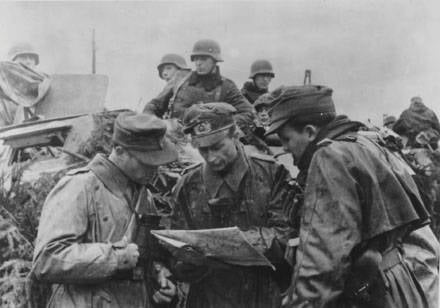 On preparation there were only 5 – 6 weeks. The order was distributed throughout the headquarters, down to the battalion. What kind of secrecy could there be? Skorzeny: “The Yankees knew everything in 5 days already!” They had long read the secret correspondence of the Reich, the air reconnaissance saw the concentration of the Nazis east of the Ardennes. Nevertheless, it seemed that, even knowing about the tricks of the Germans, they were serenely inactive.
On preparation there were only 5 – 6 weeks. The order was distributed throughout the headquarters, down to the battalion. What kind of secrecy could there be? Skorzeny: “The Yankees knew everything in 5 days already!” They had long read the secret correspondence of the Reich, the air reconnaissance saw the concentration of the Nazis east of the Ardennes. Nevertheless, it seemed that, even knowing about the tricks of the Germans, they were serenely inactive.Sabotage Express Course
Feldfebel Heinz Rohde: “Thinking that the English speakers are being recruited to the radio interception service, and this is not a dangerous business, I filed a report. After passing a language test at the headquarters, he left for the Grafenver training ground in Bavaria. There was a complete mishmash of military branches and ranks, from naval captain to corporal Luftwaffe, from infantry lieutenant to SS soldier. We learned that from now on we serve in the 150th tank brigade. Struck by the severity of security, every 20-30 m there was a sentry. Attempts to question them yielded nothing: they were Ukrainians who did not understand German. ” About 600 cadets gathered. Without giving any explanation, they were ordered to hand over their previous uniforms, documents, personal tokens, and military insignia, the main thing here was not it, but the quality of the language. Leaving the facility, all contacts with the outside world, including correspondence, was prohibited, equating violations to high treason. Rohde: “Without receiving letters, my parents wrote to my previous part and found out that I was missing.” Intense study began. The language was set by linguists and instructors who had previously served in the US Army and owned its jargon. They were sent to practice among captured Americans in the camps of Limburg and Kustrin; in military films from the USA, they saw important details: how the Yankees command, salute, behave with comrades and commanders, treat with chewing gum, a pack of cigarettes, smoke (and they never smoke a cigarette to the end), crush a cigarette, eat (only with a fork, without a knife). The rest of the time was spent on physical training, engineer and radio-equipment, shooting from American weapons. Walking in American style, cramming their ranks and positions, students even thought that a joint action against the Russians was being prepared with the United States. Details aroused gloomy suspicions. Why should a radio interception specialist be able to kill with a knife, string, bare hands? Run for hours in the landing boots in the area and jump from a window from a height of three meters? Mining with outlandish plastic explosives? Hasty activities, bombing armada of the enemy in the sky, rumors of failures at the front - their hour was drawing near. On December 14, the commander of the training center, Lt. Col. Wulf, handed over Skorzeny's express-course product. The knight's cross and the scars of the commander set that would not be easier. He dedicated them to the essence of the matter without a specific “where” and “when”: to break into the rear of the Americans at the tip of a tank wedge and carry out the mission there. Now it was possible to communicate only within the group.
"Yes", "No" and "O´kay"
Many course did not give anything. Without an accent, no more than 10 people spoke English; 40 people were fluent in English; 150 people in English could be explained; 200 people had a school level language. They had to answer the tricky questions of the US military police, without glaring! The rest understood only in German. They were trained to say “Yes”, “No”, “O´kay”, to cram curses and command words of the US Army. This meant that in practice it would be necessary to portray those who, in a panic of retreat, cannot even articulate themselves. And also: having heard the question of an American, say “Sorry”, grab his pants and run into the bushes, imitating need. This, in general, exhausted the means of language brigade disguise.
It was not possible to eliminate the characteristic for Germans manner of return / repetition of commands, driven into them by Prussian drill. They behaved like non-americans. Summary Skorzeny: “Improvisation in such an important matter can destroy everything. They never did anything like that. And for 5 weeks, it is impossible to prepare quality saboteurs. ” In order not to fail the operation, the brigade was reinforced with real specialists from the 600 SS landing battalion, the SS Center Hunting Command, and gave two landing battalions of the “Special Detachment of the Yungvirt”. Without knowing the languages, they knew how to fight well, and in this case they played the role of infantry.
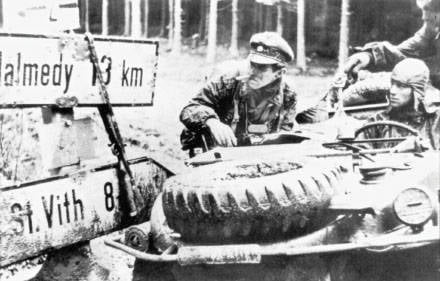 The name "150-I tank brigade" was purely conditional. Here is its composition: 90 officers, 448 non-commissioned officers, 2138 privates - just 2676 people, that is, 600 bayonets are smaller than planned. She was divided into 3 operational units X, Y, Z and a separate commando company of Senior Lieutenant Shtilau (160 people with the best language, 24 reconnaissance, 8 radio and 7 sapper groups). The detachments (commanders lieutenant colonel Wulf, Obertshurtmbannführer SS Hardik and Captain Scherf) were approximately equivalent: the landing battalion; companies: infantry, mortar, tank, air defense; platoons: sapper, communications, intelligence on armored personnel carriers. Then part of the forces of the company Shtilau transferred to the detachments (for 2 reconnaissance, 1 radio and 1 sapper group).
The name "150-I tank brigade" was purely conditional. Here is its composition: 90 officers, 448 non-commissioned officers, 2138 privates - just 2676 people, that is, 600 bayonets are smaller than planned. She was divided into 3 operational units X, Y, Z and a separate commando company of Senior Lieutenant Shtilau (160 people with the best language, 24 reconnaissance, 8 radio and 7 sapper groups). The detachments (commanders lieutenant colonel Wulf, Obertshurtmbannführer SS Hardik and Captain Scherf) were approximately equivalent: the landing battalion; companies: infantry, mortar, tank, air defense; platoons: sapper, communications, intelligence on armored personnel carriers. Then part of the forces of the company Shtilau transferred to the detachments (for 2 reconnaissance, 1 radio and 1 sapper group).Masquerade
Feldwebel Rode: “We were dressed in a warehouse, where there were mountains of American uniforms of all sizes, even underwear. From a heap of soldiers' books issued those whose photos more or less corresponded to our appearance. Now I was Sergeant Morris Woodal. I even had a photo of "my bride Eloise" from Oklahoma. They also distributed “death medallions” of fallen Americans, canned goods, cigarettes, and coffee. Everything was made in USA, even matches. Packs of dollars and pounds (from the Abwehr specialty) for a possible bribe to the enemy still smelled of paint, and ordered to crumple and wipe them: “We were shaken by the lighters with a vial of hydrocyanic acid inside. The instructor major explained that if captured, it would save us trouble. I realized that we are suicide bombers. ”
There have been absurdities. Thus, English overcoats began to be issued to fighters, while at the front the Yankees wore field jackets. And these jackets, taken from prisoners, were not suitable, because the “triangle of prisoners” was etched on them. Part of the outfit was summer. The US Army helmets collected all the 1500 pieces. Only the company Stilau was equipped with adequate form, weapons and equipment. Documents for her were made on real American paper for military documents captured by Gering's paratroopers. But the detachments of X, Y, Z are framed with grief in half. The Wehrmacht himself desperately needed trophies and tried to keep them by hook or by crook. The suppliers even offered Skorzeny the Soviet and Polish equipment unnecessary in this case. December 14, i.e., 2 the day before the operation, the crew had: 2 M4 Sherman tank (from 28 promised), 3 American M10 Wolverine ACS (from 24), XNX German (Sd.Kfz. 16 / 251, Sd.Kfz. 1 / 250, SdKfz 1 / 234 s) and 1 of American BTR (M16, M3, M8), 20 German and 55 American motorcycle, 21, American motorcycle, and one 28, American XIVUMX, 177, 15 s, German 1 s, 1 sNKX / 10 / 12, XdumX / 10, 75 / 50 s, German XNUMX, and American American BTR (XNUMX) American trucks, XNUMX German and XNUMX American tractor. Dangerous was the lack of tanks. With the superiority of the enemy in armored vehicles without their heavy tanks and adequate anti-tank weapons such an operation is unthinkable. I had to redo the "Panther". With steel screens, the outlines of their hull and turret were distorted in such a way that they slightly resembled the MU NNXX ACS, even the spare tracks hung on the sides in an American way. The “German” betrayed the chess arrangement of the rinks. Skorzeny: "Only a young recruiting Yankee, and even then in the dark at a great distance, would take our tanks for their own." XNUMX of these so-called. Panther G / MXNUMX, their StuN III XNUMX ACS self-propelled guns, armored personnel carriers and trucks painted olive green in the US Army, were divided between X, Y and Z. The US Army drew white stars and tactical numbers. They dabbed fresh paint in order not to be noticed by the cleanliness of the boards against the background of winter dirt. In the arsenal of the brigade were mortars, howitzers, anti-tank guns, anti-aircraft guns, heavy machine guns made in Germany and the USA. There was a shortage of American ammunition: several wagons of shells that were assembled with difficulty were blown up on air by negligence. Small arms scored only XNUMX% of fighters, and the rest had to be left with the German. Later, Skorzeny called the equipment of the brigade "catastrophic." Nevertheless, she took the initial positions. The equipment was refueled to a minimum. According to complex calculations, petrol was poured in such a way that everyone would get to about the same frontier without scattering along the way. Hoping in the enemy's rear to transfer to a new technique and refuel.
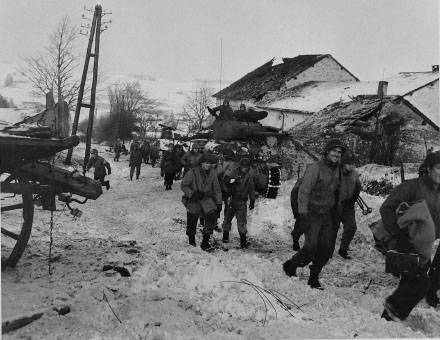 In the early morning of December 15, the Currency group (4 5 team in the US Army uniform) secretly left for Holland and Belgium with a load of XM million Belgian and French francs in 30. Abwehr special typography notes were paid for “silent sabotage” of military shipments that went through local ports and railways. It was important during Operation Guard on the Rhine to slow down the supply of weapons and ammunition to the Anglo-Saxons, using the local population for this purpose.
In the early morning of December 15, the Currency group (4 5 team in the US Army uniform) secretly left for Holland and Belgium with a load of XM million Belgian and French francs in 30. Abwehr special typography notes were paid for “silent sabotage” of military shipments that went through local ports and railways. It was important during Operation Guard on the Rhine to slow down the supply of weapons and ammunition to the Anglo-Saxons, using the local population for this purpose.150 Brigade in “Guard on the Rhine”
16 December, 5: 15 in the morning: hundreds of searchlights lit the enemy's line of defense, German shells and missiles covered her with a roar, tanks advanced. Troops X, Y, Z rushed into the breached parallel routes. But the start was unsuccessful. The commander of Detachment X, Obertshurtmbannführer Hardik, hit a German mine and was killed on the spot. One of the units with a complete set of the Vulture operation plan was completely captured by the 1 Company of the 424 Infantry Regiment of the US Army 106 Division under the command of Lieutenant William W. Shakespeare 1 (!). This later helped the enemy to meet Skorzeny people "from all trunks." The day passed, but none of the armored fists of the Wehrmacht and the SS did not make it to the designated lines, slowing down the pressure more and more. If frightening "royal tigers" and SS professionals got stuck in the enemy's defense, then what about the 150 Brigade ... Having lost 25 people only killed on the first day, she couldn’t carry out the main task (capture of bridges). Skorzeny: “It was impossible to get through to Meuse. The enemy did not retreat without resistance, and only this gave us any chance of success. ” December 18 operation stalled, the meaning of the masquerade disappeared. Skorzeny threw the brigade into battle in German uniform, as an ordinary front-line unit. She attacked the city of Malmedy on the northern flank, stumbled upon a solid defense, unsuccessfully trodden there and by the evening of December 22 returned to its original positions.
The affairs of the Štilau company, in which Felebel Pélode was, were different. She submitted to Skorzeny himself, was equipped much better than the X, Y and Z detachments, in her were all the "speakers" (native speakers). Groups in jeeps consisted of a commander, a driver, a radio operator with a backpack VHF-radio (or a miner), and a speaker: he led all conversations with the enemy. Immediately upon arrival at the front, the company was isolated from the rest of the brigade and guarded by couriers. The saboteurs, already in the form of the enemy, communicated only in a foreign language, training their fluency. Just a couple of hours before the group arrived, they were given detachments X, Y, Z and divisions of the I tank corps of the SS, under whose protection they had to go as far as possible without loss. Since the pace of the operation was disrupted, they went into action only on December 17; imperceptibly merging with the flow of waste troops, spread over the American rear. For recognition of their own, they used multi-colored scarves, took off their helmets, unbuttoned their chin straps. The "specialization" of the groups was different. The task of the "communication" / "conductors" (3 – 4 man) was the destruction of lines, communication centers; elimination / rearrangement of road shields, marking of minefields. The miners (5 – 6 people) blew up bridges, fuel depots, ammunition, fuel stations; mined well. d. ways, did obstructions on the roads. The purpose of the “military police” (3 – 4 man) was misinformation, sowing panic, sending false orders to the enemy, sending him off-road, detours, dead ends. “Scouts” (3 – 4 man), having penetrated far to the west, reported the headquarters about the enemy’s movements, character, quantity, and arming of his troops. And they all captured / destroyed officers, couriers, signalmen; harmed wherever and whenever possible. Already simple manipulation with track signs made the military columns stand for hours in traffic jams. One American tank regiment "sent" so well that he got lost in the Ardennes and was found by his own command only after 2 of the day. Communication between the armies of Generals Bradley and Hodges was seriously disrupted.
The submission of the groups continued until December 19. From those who returned after the first days they formed three new groups (commanders, captain-lieutenant Schmidt, captain Shtilau, sergeant-major Rode) and sent him off the front line. The Luftwaffe was completely knocked out by that moment, the air reconnaissance was gone, so they went to collect vital information for the headquarters by simple observation, keeping their feet only with the help of pervitin (a remedy for sleep).
"You're one of Skorzeny's thugs!"
Despite the modest successes of these disparate groups, an indescribable panic arose in the rear of the Allies. French Radio Calais reported that the German thugs had already taken 250 into captivity. It was reported that in Nice (it is far in the south of France!) German paratroopers devastated one of the banks. Paris correspondent of the English Daily Telegraph: “The city is full of English-speaking German saboteurs with cold weapons. Their goal is seduction and the subsequent killing of Allied soldiers. ” Frightened by rumors that in the catacombs of Paris, people Skorzeny are preparing to seize the city. Leaked "secret information": the place of their collection - Paris "Cafe de la Paix" - and the area was cordoned off by the Allied military police. Panic reached its peak after the ordinary 1 class of the US Army Lawrence (aka German non-commissioned officer Billing), Zenzenbach (Feldwebel Schmidt) and van der Woerth (non-commissioned officer Pernass) were detained near the village of Evay south of Liege. They found explosives, lighters with poison, fresh 100-dollar bills, a German walkie-talkie. They were shot, but before they were told that their goal was to liquidate the commander-in-chief of the allied forces, General Eisenhower. The reason for such a statement could be the excessive secrecy of operation “Grif”. Her true tasks knew only Skorzeny himself, always denying the fact of such a task. What the soldiers didn’t say back, they thought out for themselves. However, knowing the image of the “Man with a Scar”, counterintelligence CIC had no right to take risks and moved the general to a new apartment, a real fortress. And Lieutenant Colonel Smith, very similar to Eisenhower, as a decoy duck cruised in a perceptible general jeep between his villa in Saint-Germain-en-Laye and the headquarters in Fontainebleau to divert the killers to themselves.
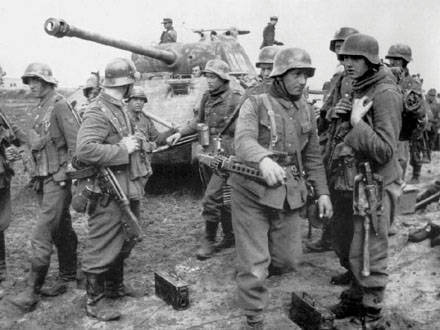 The Germans seemed to be everywhere. In the territory occupied by the Americans, counterintelligence, military police, and thousands of soldiers hunted them day and night. A system of test questions was developed, which only a true Yankee could answer. For example, “What is the name of Mickey Mouse's sister?”, “Which team won the US baseball championship in the 34 year?”, Etc. Everyone was forced to utter the word wreath (“crown”). The combination of the letters w, r, and th betrayed any German, but this included recent immigrants in the United States, of whom there were a great many in the US Army. Everyone knew: on demand, you need to stop, with your hands up, slowly get out of the car, at the guns of a weapon aimed at you, quickly and without an accent, answer the strange questions of the patrol. Knowledge of the password and personal documents did not release this procedure. There was an order to detain all suspicious regardless of rank. Even General Bradley had to prove that he was from the States. Here are the questions asked to him: “Illinois capital?”, “Actress Betty Grable's husband's name?” General Clark, who stopped north of Saint-Vi, answered the questions, heard: “You are one of these thugs Skorzeny!” - and got into the bullpen . So almost 2500 of the real Yankees, hundreds of Englishmen were caught. A week was spent in the cell by an American officer who wore German boots because of their convenience.
The Germans seemed to be everywhere. In the territory occupied by the Americans, counterintelligence, military police, and thousands of soldiers hunted them day and night. A system of test questions was developed, which only a true Yankee could answer. For example, “What is the name of Mickey Mouse's sister?”, “Which team won the US baseball championship in the 34 year?”, Etc. Everyone was forced to utter the word wreath (“crown”). The combination of the letters w, r, and th betrayed any German, but this included recent immigrants in the United States, of whom there were a great many in the US Army. Everyone knew: on demand, you need to stop, with your hands up, slowly get out of the car, at the guns of a weapon aimed at you, quickly and without an accent, answer the strange questions of the patrol. Knowledge of the password and personal documents did not release this procedure. There was an order to detain all suspicious regardless of rank. Even General Bradley had to prove that he was from the States. Here are the questions asked to him: “Illinois capital?”, “Actress Betty Grable's husband's name?” General Clark, who stopped north of Saint-Vi, answered the questions, heard: “You are one of these thugs Skorzeny!” - and got into the bullpen . So almost 2500 of the real Yankees, hundreds of Englishmen were caught. A week was spent in the cell by an American officer who wore German boots because of their convenience.What came across the Germans? December 18 fighters with good English were arrested south of Lutthich, asking for refueling with the words “Petrol, please!” This number would have passed in England, and in the States they would call gasoline the word Gas. Feldwebel Rode: “It seemed that the GI taught us a mile away. Then we saw: they are not up to us, camouflage is enough. But we were wrong. How was it to know that they do not drive jeeps on 5 – 6 people? They have a lot of machines, and in each sat 2 – 3 fighter. And that they either turn on all the lights, or drive without any lights at all? And we put on the covers: blackout! Noticing at dawn that no one else had this, they wanted to inform the headquarters, but because of the danger of direction finding, communication was strictly limited. ” Two groups caught exactly on the headlights.
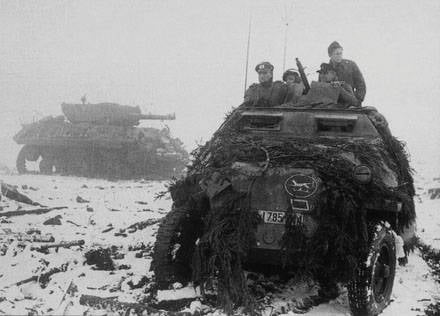 The Americans asserted that 130 “Krauts” were neutralized (English slang: Kraut is a “German soldier”), but the Germans always disputed this: “18 people were caught by Skorzeny, and the names and titles of only 13 of them were revealed” - 13 people were executed in the city of Hyu; Five were captured while attempting to shoot a bridge from a tank gun and also executed. However, it is also known that while collecting the remnants of the company in Vallerode castle near Saint-Wee, it turned out that she had lost her 2 / 3 of her composition. The X, Y and Z troops lost 15% of personnel and most of the equipment, including from the repeated blows of the Luftwaffe. Many commanders died, the Scarface has more scars: he received a charge of shrapnel in the face, almost losing an eye.
The Americans asserted that 130 “Krauts” were neutralized (English slang: Kraut is a “German soldier”), but the Germans always disputed this: “18 people were caught by Skorzeny, and the names and titles of only 13 of them were revealed” - 13 people were executed in the city of Hyu; Five were captured while attempting to shoot a bridge from a tank gun and also executed. However, it is also known that while collecting the remnants of the company in Vallerode castle near Saint-Wee, it turned out that she had lost her 2 / 3 of her composition. The X, Y and Z troops lost 15% of personnel and most of the equipment, including from the repeated blows of the Luftwaffe. Many commanders died, the Scarface has more scars: he received a charge of shrapnel in the face, almost losing an eye.Experience the Power of Effective Results
Now about the "stupidity" of the Americans, "not expecting a German counterattack." Most likely, there was no stupidity. The fact is that the Western Allies have long read the entire secret correspondence of the Third Reich. They knew the details of any plan of the Germans. And therefore, it was they who held liquid forces on the Ardennes sector of the front, which German intelligence reported to its command, which decided to strike here. Then everything went according to plan - the American plan. On December 16, the Germans went forward, penetrating the enemy’s defenses like butter. He ran west, the Germans followed him, went far - and suddenly got bogged down. The Americans were retreating, but not all. The 82nd and 101st airborne divisions, still bleeding from a massacre in the Netherlands (Operation Market Garden), rested themselves dead. The intersection of the main roads in the Ardennes, the city of Bastogne was not able to take the whole 5th German army tank. The city of Saint-Vie, also the intersection of important routes, they took not on the 17th as they wanted, but on December 21st. Because of such delays, their entire plan collapsed, fuel ran out, people died. The offensive drowned on December 25, only 6 km from the bridge over the Meuse in Dinan. It was the tip of the "Ardennes ledge", that is, the Germans broke through 90 km. And then the weather improved and aviation Allies began to shred their troops and supply lines. Ultimately, the "ledge" was eliminated along with those in it. The direct consequence of this was the Allied invasion of Germany.
Yes, the Yankees did not keep the blow, retreated, surrendered. Well, no one of them was told that all this is happening for the sake of a more priority goal — to cause irreparable losses to the Germans and their subsequent final defeat.
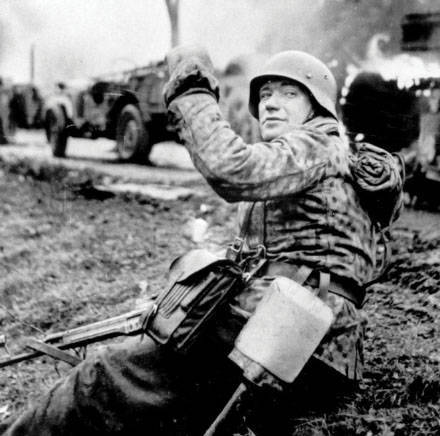 This goal was known only to the High Command, and it went to the temporary loss of territory, to the loss of manpower and equipment. The end justified the means.
This goal was known only to the High Command, and it went to the temporary loss of territory, to the loss of manpower and equipment. The end justified the means.The result is obvious: the Americans made up for their losses in the 2 – 3 week. The Germans didn’t compensate their losses anymore, losing more than a third of the armored vehicles here (and each TigrII, Tigr, Panther cost a dozen enemy tanks), almost all aircraft (including jet), resources, fuel, ammunition, which they then so lacked. "Guard on the Rhine" completely failed; even tactical tasks were not solved - the seizure of bridges, the Germans did not even reach the river. They retreated, despite the shouts of the Fuhrer. Operation “Grief” did not help his absurd idea either, which became the grave for many of the men in the backs with a sabotage “express course”. The 150 Brigade participated in the battles until December 28, after which it was disbanded. Most of the survivors returned to their former units, some joined the SS and remained with Skorzeny. The actions of his saboteurs "framed" all German soldiers on the western front. At the beginning of 45, their supply was so bad that they widely used captured American field jackets and other elements of uniforms. After the operation “Vulture” it became very dangerous: if captured, they could put anyone as a saboteur to the wall.
... Feldwebel Rode wrote in his memoirs that no more than three people from the Stilau company lived to the end of the war.
Information